Identification of Critical Source Areas (CSAs) and Evaluation of Best Management Practices (BMPs) in Controlling Eutrophication in the Dez River Basin
Abstract
:1. Introduction
2. Materials and Methods
2.1. Study Area and Data
2.2. SWAT and SWAT-CUP
- Step 1: The objective function is defined and the absolute range of parameters, based on the recommended values in the software, is set.
- Step 2: Absolute sensitivity analysis is carried out, using Latin Hypercube sampling. The objective function is computed.
- Step 3: The sensitivity matrix of the objective function is calculated. Equivalent of the Hessian matrix is formulated.
- Step 4: High order derivatives are neglected. Based on the Cramer Rao Theorem, an estimate of lower bound of parameter covariance is computed.
- Step 5: Parameter sensitivity is analyzed using multiple regression.
- Step 6: Uncertainty measures (p-factor and r-factor) are computed.
2.3. Identification of CSAs
2.4. BMPs and Pollution Load Indices
3. Results and Discussion
3.1. Sensitivity Analysis
3.2. Calibration and Validation
3.3. Identifying the CSAs
3.4. Evaluation of the BMPs
4. Conclusions
- A significant decrease in TN (42.61%) and TP (39.57%) loads were observed in areas with irrigated farming where 10 m filter strips were implemented.
- Reducing the number of livestock was not effective in reducing phosphorous compounds.
- The mulching of the river channel walls did not have much impact on reducing pollution.
- Using combined indices to identify CSAs without weighting variables is not desirable, and CSAs should be weighed according to the priority of the variables.
Author Contributions
Funding
Conflicts of Interest
References
- Dawadi, S.; Ahmad, S. Evaluating the Impact of Demand-Side Management on Water Resources under Changing Climatic Conditions and Increasing Population. J. Environ. Manag. 2013, 114, 261–275. [Google Scholar] [CrossRef]
- Ahmad, S. Managing Water Demands for a Rapidly Growing City in Semi-Arid Environment: Study of Las Vegas, Nevada. Int. J. Water Res. Arid Environ. 2016, 5, 35–42. [Google Scholar]
- Amoueyan, E.; Ahmad, S.; Eisenberg, J.; Pecson, B.; Gerrity, D. Quantifying Pathogen Risks Associated with Potable Reuse: A Risk Assessment Case Study for Cryptosporidium. Water Res. 2017, 119, 252–266. [Google Scholar] [CrossRef]
- Choubin, B.; Khalighi-Sigaroodi, S.; Malekian, A.; Ahmad, S.; Attarod, P. Drought Forecasting in a Semi-Arid Watershed Using Climate Signals: A Neuro-Fuzzy Modeling Approach. J. Mount. Sci. 2014, 11, 1593–1605. [Google Scholar] [CrossRef]
- Huang, J.; Lin, J.X.; Wang, J. The Precipitation Driven Correlation Based Mapping Method (PCM) for Identifying the Critical Source Areas of Non-Point Source Pollution. J. Hydrol. 2005, 524, 100–110. [Google Scholar] [CrossRef]
- Thakali, R.; Kalra, A.; Ahmad, S.; Qaiser, K. Management of An Urban Stormwater System Using Projected Future Scenarios of Climate Models: A Watershed-Based Modeling Approach. Open Water J. 2018, 5, 1. [Google Scholar]
- Venkatesan, A.; Ahmad, S.; Johnson, W.; Batista, J. System Dynamics Model to Forecast Salinity Load to the Colorado River Due to Urbanization within the Las Vegas Valley. Sci. Total Environ. 2011, 409, 2616–2625. [Google Scholar] [CrossRef]
- Natha, S.B.; Allan, J.D.; Dolan, D.M.; Han, H.; Richards, R.P. Application of the Soil and Water Assessment Tool for Six watersheds of Lake Erie: Model parameterization and calibration. J. Great Lakes Res. 2011, 37, 263–271. [Google Scholar] [CrossRef]
- Niraulaa, R.; Kalinb, L.; Srivastavac, P.; Anderson, C.J. Identifying Critical Source Areas of Non-Point Source Pollution with SWAT and GWLF. Ecol. Model. 2013, 268, 123–133. [Google Scholar] [CrossRef]
- Panagopoulos, Y.; Makropoulos, C.; Mimikou, M. Decision Support for Diffuse Pollution Management. Environ. Model. Softw. 2012, 30, 57–70. [Google Scholar] [CrossRef]
- Nazari-Sharabian, M.; Ahmad, S.; Karakouzian, M. Climate Change and Eutrophication: A Short Review. Eng. Technol. Appl. Sci. Res. 2018, 8, 3668–3672. [Google Scholar] [CrossRef]
- Chaplot, V.; Saleh, A.; Jaynes, D.B.; Arnold, J.G. Predicting Water, Sediment, and NO3-N Loads Under Scenarios of Land-Use and Management Practices in a Flat Watershed. Water Air Soil Pollut. 2014, 154, 271–293. [Google Scholar] [CrossRef]
- Santhi, C.; Srinivasan, R.; Arnold, J.G.; Williams, J.R. A Modeling Approach to Evaluate the Impacts of Water Quality Management Plans Implemented in a Watershed in Texas. Environ. Model. Softw. 2006, 21, 1141–1157. [Google Scholar] [CrossRef]
- Ghumman, A.R.; Ahmad, S.; Khan, R.A.; Hashmi, H.N. Comparative Evaluation of Implementing Participatory Irrigation Management in Punjab Pakistan. Irrig. Drain. 2014, 63, 315–327. [Google Scholar] [CrossRef]
- Pisinaras, V.; Petalas, C.; Gikas, G.D.; Gemitzi, A.; Tsihrintzis, V.A. Hydrological and Water Quality Modeling in a Medium-Sized Basin Using the Soil and Water Assessment Tool (SWAT). Desal 2009, 250, 274–286. [Google Scholar] [CrossRef]
- Bracmort, K.S.; Arabi, M.; Frankenberger, J.R.; Engel, B.A.; Arnold, J.G. Modeling Long-Term Water Quality Impact of Structural BMPs. Trans. ASABE 2006, 49, 367–374. [Google Scholar] [CrossRef]
- Santhi, C.; Arnold, J.G.; Williams, J.R.; Hauck, L.M.; Dugas, W.A. Application of a Watershed Model to Evaluate Management Effects on Point and Nonpoint Source Pollution. Trans. ASABE 2001, 44, 1559–1570. [Google Scholar] [CrossRef]
- Bouraoui, F.; Benabdallah, S.; Jrad, A.; Bidoglio, G. Application of the SWAT Model on the Medjerda River Basin (Tunisia). Phys. Chem. Earth 2005, 30, 497–507. [Google Scholar] [CrossRef]
- Arabi, M.; Govindaraju, R.S.; Hantush, M.M. Cost-Effective Allocation of Watershed Management Practices Using a Genetic Algorithm. Water Resour. Res. 2006, 42, W10429. [Google Scholar] [CrossRef]
- Ficklin, D.L.; Luo, Y.; Zhang, M. Watershed Modelling of Hydrology and Water Quality in the Sacramento River Watershed, California. Hydrol. Process. 2012, 27, 236–250. [Google Scholar] [CrossRef]
- Zhang, X.; Zhang, M. Modeling Effectiveness of Agricultural BMPs to Reduce Sediment Load and Organophosphate Pesticides in Surface Runoff. Sci. Total Environ. 2012, 409, 1949–1958. [Google Scholar] [CrossRef]
- Liu, R.; Xu, F.; Zhang, P.; Yu, W.; Men, C. Identifying Non-Point Source Critical Source Areas Based on Multi-Factors at a Basin Scale with SWAT. J. Hydrol. 2016, 533, 379–388. [Google Scholar] [CrossRef]
- Dong, F.; Liu, Y.; Wu, Z.; Chen, Y.; Guo, H. Identification of Watershed Priority Management Areas under Water Quality Constraints: A Simulation-Optimization Approach with Ideal Load Reduction. J. Hydrol. 2018, 562, 577–588. [Google Scholar] [CrossRef]
- Qiu, J.; Shen, Z.; Huang, M.; Zhang, X. Exploring Effective Best Management Practices in the Miyun Reservoir Watershed. China Ecol. Eng. 2018, 123, 30–42. [Google Scholar] [CrossRef]
- Agricultural Comprehensive Plan of Khuzestan Province. Available online: http://ajkhz.ir/main/ (accessed on 15 January 2019).
- Arnold, J.G.; Srinivasan, R.; Muttiah, R.S.; Allen, P.M. Large Area Hydrologic Modeling and Assessment Part I: Model development. J. Am. Water Resour. 1999, 34, 37–89. [Google Scholar] [CrossRef]
- Kiniry, J.R.; Williams, J.R.; King, K.W. Soil and Water Assessment Tool Theoretical Documentation, version 2009; Center for Agricultural & Rural Development: Ames, IA, USA, 2011; p. 618. [Google Scholar]
- Shang, X.; Wang, X.; Zhang, D.; Chen, W.; Chen, X.; Kong, H. An Improved SWAT-Based Computational Framework for Identifying Critical Source Areas for Agricultural Pollution at the Lake Basin Scale. Ecol. Model. 2012, 226, 1–10. [Google Scholar] [CrossRef]
- Abbaspour, K.C.; Yang, J.; Maximov, I.; Siber, R.; Bogner, K.; Mieleitner, J.; Zobrist, J.; Srinivasan, R. Modelling Hydrology and Water Quality in the Pre-Alpine/Alpine Thur Watershed using SWAT. J. Hydrol. 2007, 333, 413–430. [Google Scholar] [CrossRef]
- Nash, J.E.; Sutcliffe, J.V. River Flow Forecasting Through Conceptual Models: Part 1—A Discussion of Principles. J. Hydrol. 1970, 10, 282–290. [Google Scholar] [CrossRef]
- Moriasi, D.N.; Arnold, J.G.; Van Liew, M.W.; Bingner, R.L.; Harmel, R.D.; Veith, T.L. Model Evaluation Guidelines for Systematic Quantification of Accuracy in Watershed Simulations. Trans. ASABE 2007, 50, 885–900. [Google Scholar] [CrossRef]
- Winchell, M.F.; Folle, S.; Meals, D. Using SWAT for Sub-Field Identification of Phosphorus Critical Source Areas in a Saturation Excess Runoff Region. Hydrol. Sci. J. 2015, 60, 844–862. [Google Scholar] [CrossRef]
- White, M.J.; Arnold, J.G. Development of a Simplistic Vegetative Filter Strip Model for Sediment and Nutrient Retention at the Field Scale. Hydrol. Proc. 2009, 23, 1602–1616. [Google Scholar] [CrossRef]


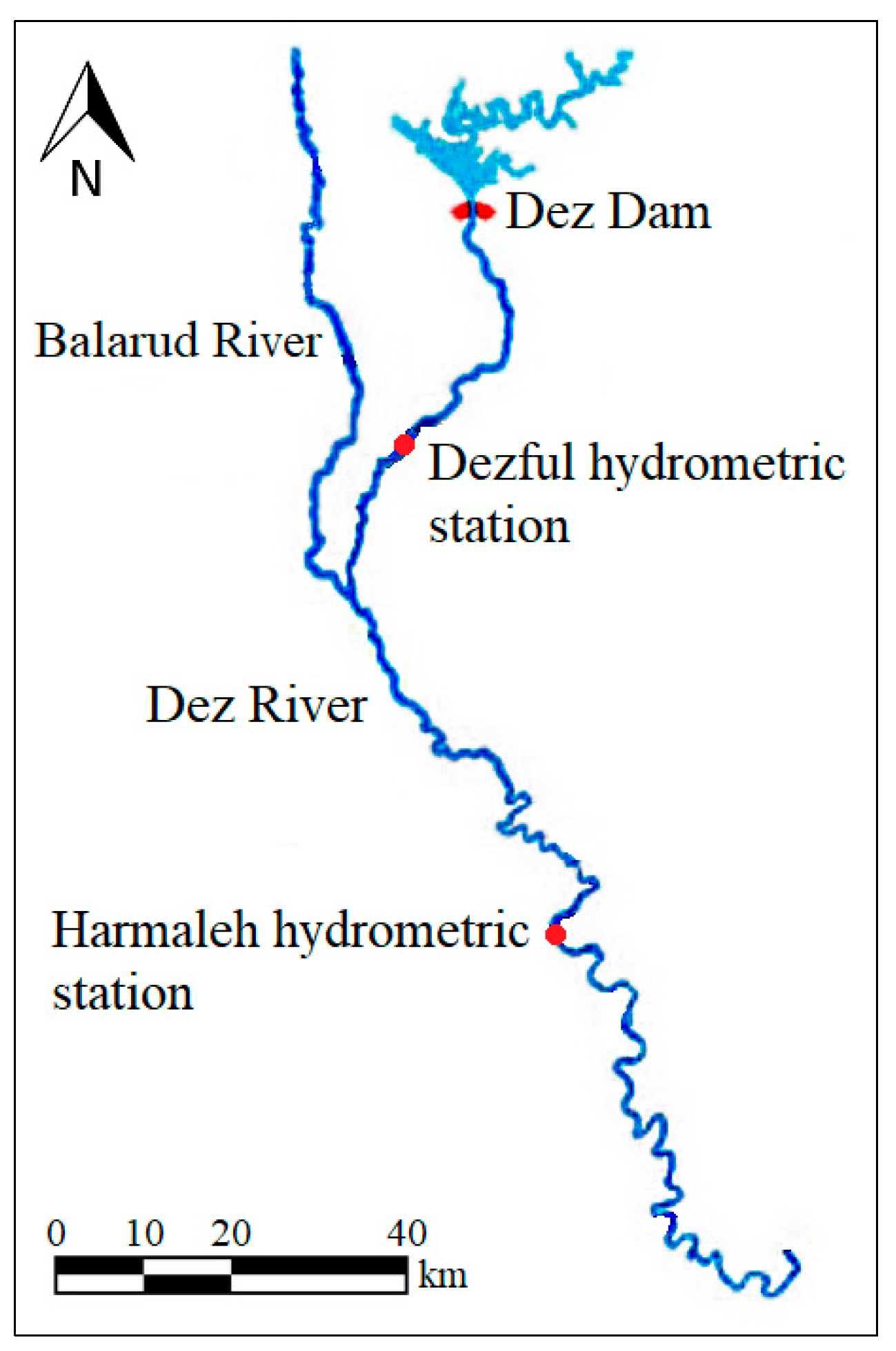

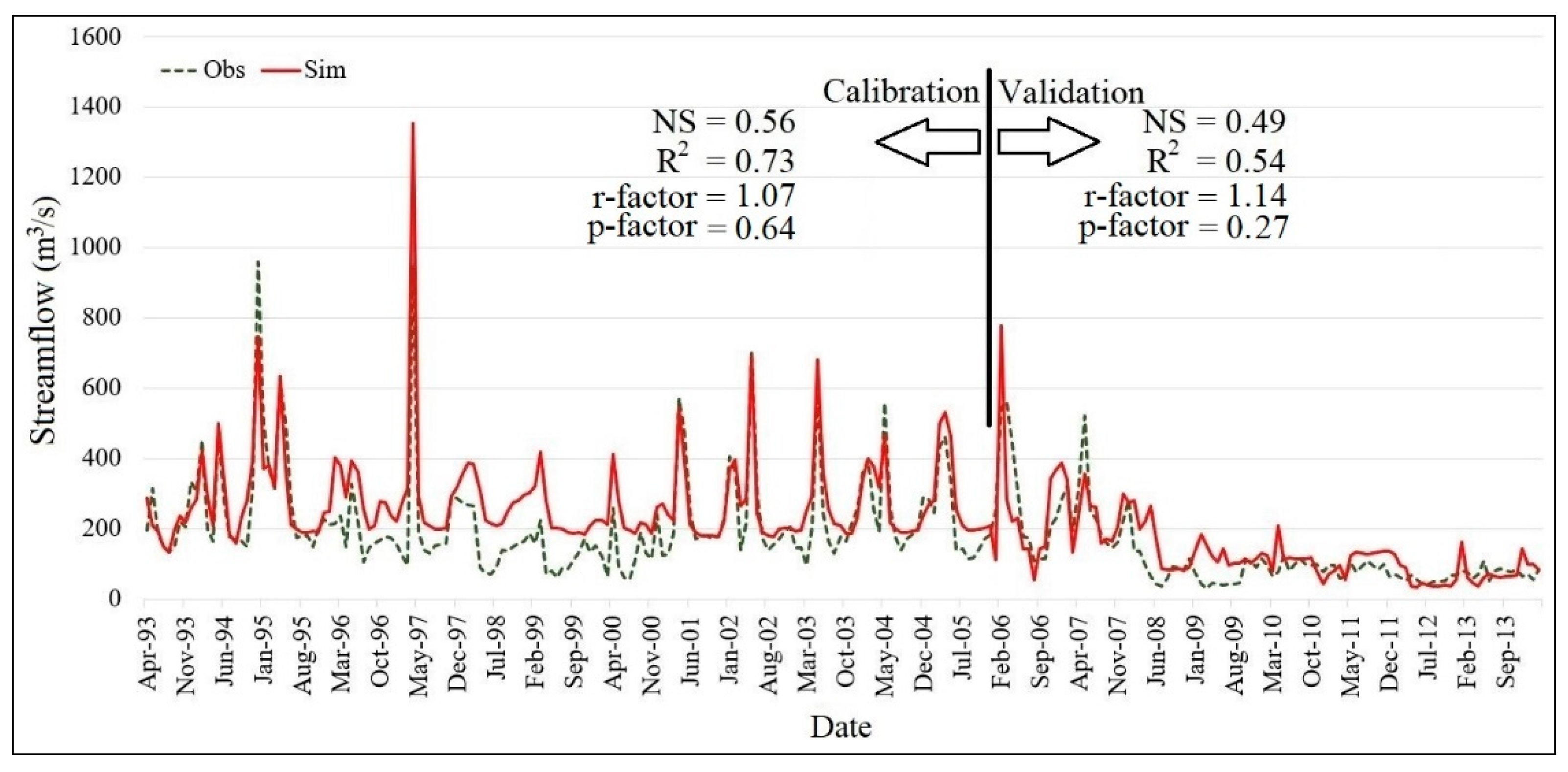
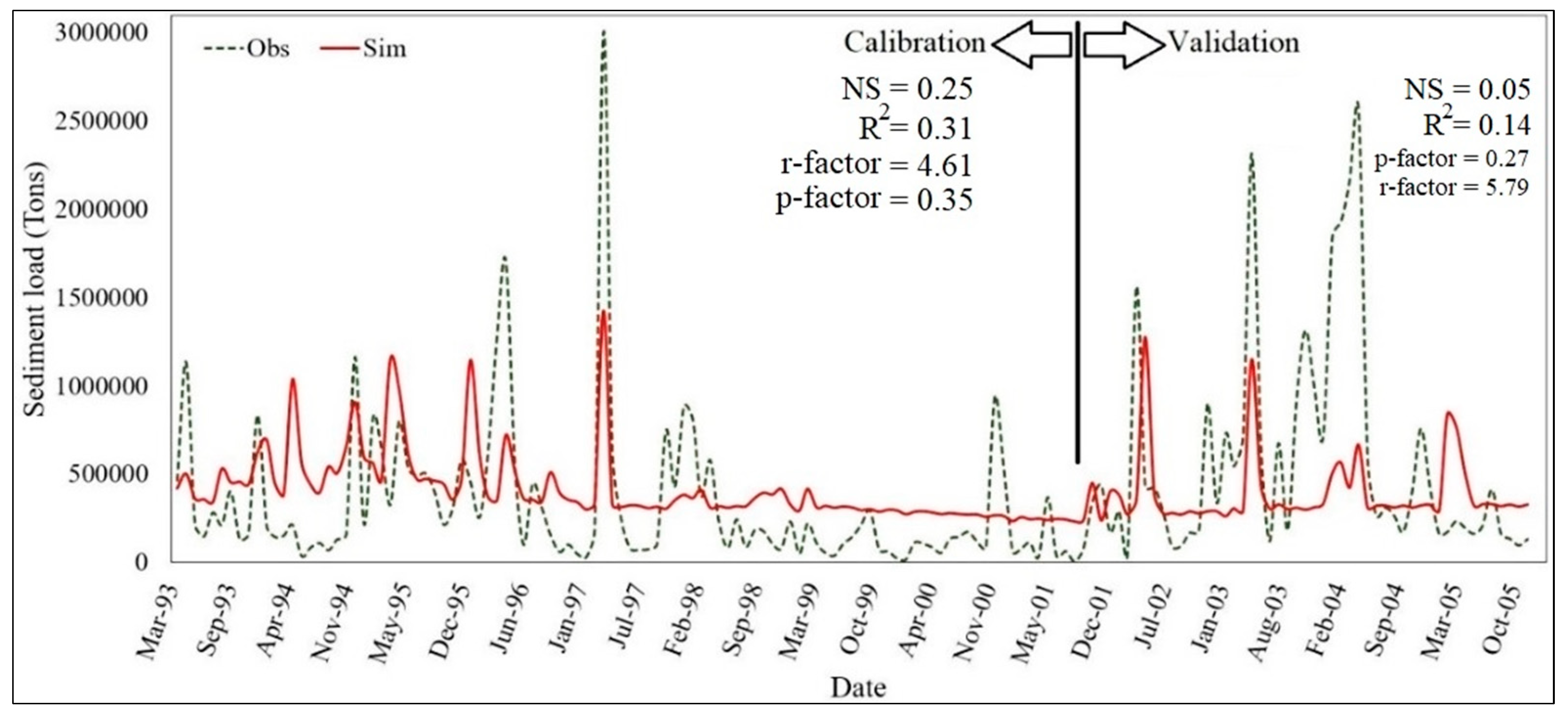
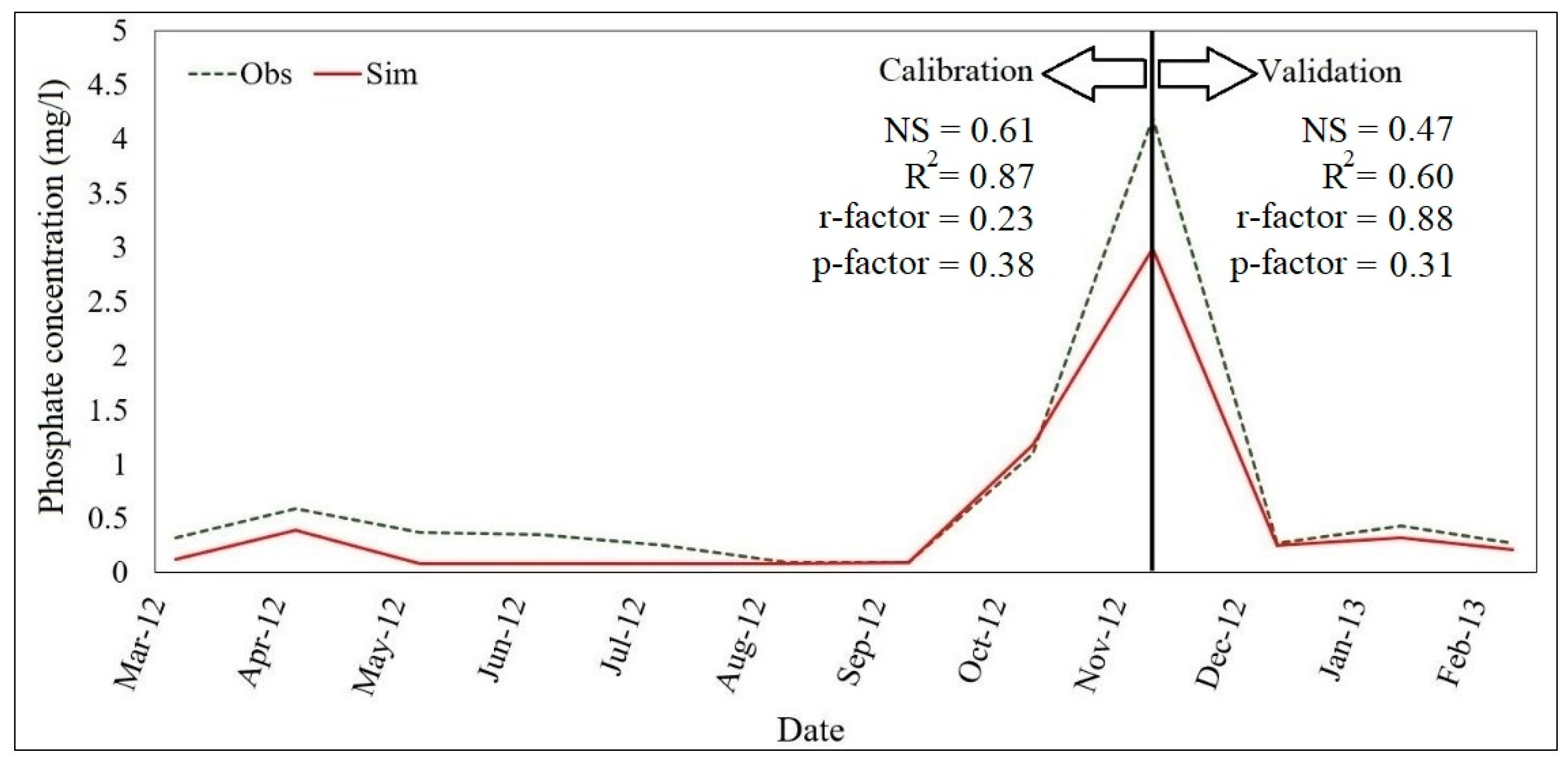


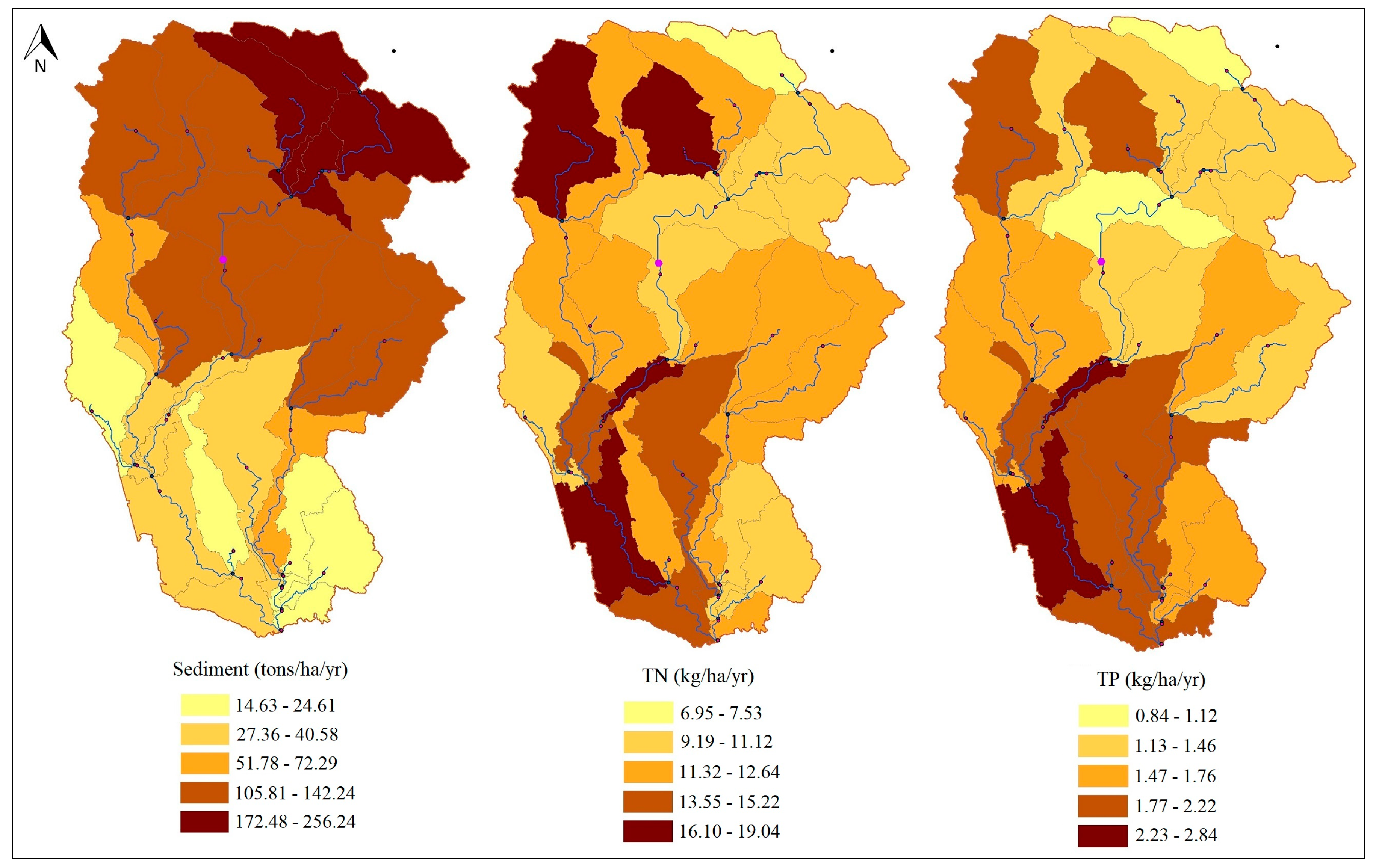


| Data | Source |
|---|---|
| Digital Elevation Model (DEM)-2011 | United States Geological Survey (USGS) |
| Soil map-2011 | FAO Soils Portal |
| Land use map-2006 | Iran’s Forests, Range and Watershed Management Organization |
| Meteorological data-(1991–2014) | I.R. of Iran Meteorogical Organization |
| Hydrometric and sediment data-(1991–2014) | Khuzestan Water and Power Authority |
| Water quality and point source pollution data-2012 | Directorate General of Environmental Protection of Khuzestan Province |
| Management and agricultural data | Royan Consulting Engineers |
| Parameter | Definition | Calibrated Value | t-Stat | p-Value |
|---|---|---|---|---|
| Parameters Affecting Streamflow | ||||
| ALPHA_BF.gw | Baseflow alpha factor (1/days) | 0.0037 | −10.35 | 0 |
| CH_K2.rte | Effective hydraulic conductivity in main channel alluvium (mm/h) | 352.12 | 4.15 | 0 |
| OV_N.hru | Manning’s “n” value for overland flow | 12.41 | 2.41 | 0.016 |
| SOL_AWC.sol | Available water capacity of the soil layer (mm H2O/mm soil) | 0.214 | 1.83 | 0.067 |
| GW_REVAP.gw | Groundwater “revap” coefficient | 0.092 | −1.73 | 0.085 |
| CANMX.hru | Maximum canopy storage (mm H2O) | 53.74 | −1.63 | 0.104 |
| CH_S2.rte | Average slope of main channel along the channel length (m/m) | 6.7 | 1.59 | 0.112 |
| GW_DELAY.gw | Ground water lag time | 108.7 | −1.48 | 0.14 |
| Parameters Affecting Sediment Load | ||||
| SPCON.bsn | The linear parameter for calculating the maximum amount of sediment that can be reentrained during channel sediment routing | 0.00116 | −41.45 | 0 |
| SPEXP.bsn | Exponent parameter for calculating sediment reentrained in channel sediment routing | 1.015 | 6.73 | 0 |
| CH_ERODMO.rte | Erosion rate of the channel | 0.457 | 1.49 | 0.136 |
| ADJ_PKR.bsn | Peak rate adjustment factor for sediment routing in the sub-basin (tributary channels) | 0.907 | −0.67 | 0.5 |
| Parameters Affecting Phosphate Load | ||||
| ERORGP.hru | Phosphorus enrichment ratio for loading with sediment | 2.52 | −3.43 | 0 |
| ORGP_con.hru | Organic phosphorus concentration in runoff, after urban BMP is applied | 26.95 | 2.84 | 0.004 |
| PSP.bsn | Phosphorus availability index | 0.44 | 0.92 | 0.42 |
| SOLP_con.hru | Soluble phosphorus concentration in runoff, after urban BMP is applied | 0.231 | −0.33 | 0.73 |
| Parameters Affecting Nitrate Load | ||||
| SOLN_con.hru | Concentration of nitrogen soluble in runoff | 0.132 | −3.64 | 0 |
| NPERCO.bsn | Nitrate percolation coefficient | 0.172 | −2.05 | 0.172 |
| ERORGN.hru | Organic N enrichment ratio for loading with sediment | 2.81 | 0.119 | 0.9 |
| K_N.wwq | Michaelis-Menton half-saturation constant for nitrogen (mg N/L) | 0.174 | 0.058 | 0.953 |
| BMP | ORG_N | NO3 | NO2 | NH4 | TN | ORG_P | MIN_P | TP |
|---|---|---|---|---|---|---|---|---|
| Point source pollution elimination | 10.28 | 14.4 | 23.53 | 13.16 | 16.21 | 6.07 | 12.46 | 12.98 |
| 5 m filter strip (irrigated farming) | 18.21 | 48.51 | 18.95 | 18.68 | 31.48 | 32.4 | 41.38 | 33.28 |
| 10 m filter strip (irrigated farming) | 20.26 | 58.92 | 29.41 | 29.85 | 42.61 | 43.77 | 51.94 | 39.57 |
| 5 m filter strip (dryland farming) | 17.79 | 41.47 | 19.71 | 21.58 | 29.34 | 31.09 | 38.31 | 29.09 |
| 5 m filter strip (residential) | 9.62 | 22.48 | 14.32 | 13.81 | 16.75 | 16.76 | 19.18 | 17.98 |
| 20% reduction in livestock | 3.37 | 5.23 | 0.31 | 1.02 | 3.12 | 0.57 | 0.54 | 0.29 |
| 50% reduction in livestock | 8.71 | 14.21 | 0.48 | 3.94 | 6.34 | 0.97 | 0.96 | 0.43 |
| Mulching the channel walls | 0.1 | 0.08 | 0.03 | 0.07 | 0.43 | 0.19 | 0.58 | 0.62 |
| Fixing the channel walls | 26.1 | 43.4 | 9.12 | 7.37 | 41.78 | 29.56 | 22.96 | 30.01 |
© 2019 by the authors. Licensee MDPI, Basel, Switzerland. This article is an open access article distributed under the terms and conditions of the Creative Commons Attribution (CC BY) license (http://creativecommons.org/licenses/by/4.0/).
Share and Cite
Babaei, H.; Nazari-Sharabian, M.; Karakouzian, M.; Ahmad, S. Identification of Critical Source Areas (CSAs) and Evaluation of Best Management Practices (BMPs) in Controlling Eutrophication in the Dez River Basin. Environments 2019, 6, 20. https://doi.org/10.3390/environments6020020
Babaei H, Nazari-Sharabian M, Karakouzian M, Ahmad S. Identification of Critical Source Areas (CSAs) and Evaluation of Best Management Practices (BMPs) in Controlling Eutrophication in the Dez River Basin. Environments. 2019; 6(2):20. https://doi.org/10.3390/environments6020020
Chicago/Turabian StyleBabaei, Hadi, Mohammad Nazari-Sharabian, Moses Karakouzian, and Sajjad Ahmad. 2019. "Identification of Critical Source Areas (CSAs) and Evaluation of Best Management Practices (BMPs) in Controlling Eutrophication in the Dez River Basin" Environments 6, no. 2: 20. https://doi.org/10.3390/environments6020020
APA StyleBabaei, H., Nazari-Sharabian, M., Karakouzian, M., & Ahmad, S. (2019). Identification of Critical Source Areas (CSAs) and Evaluation of Best Management Practices (BMPs) in Controlling Eutrophication in the Dez River Basin. Environments, 6(2), 20. https://doi.org/10.3390/environments6020020








